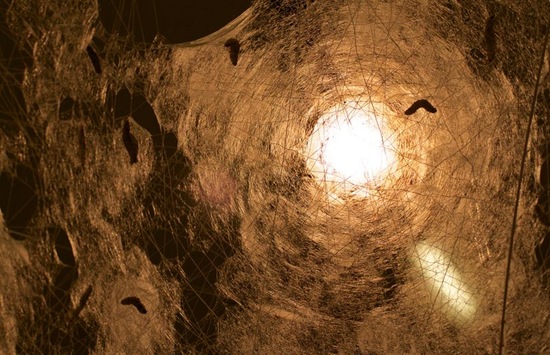
A Mind-Blowing Dome Made by 6,500 Computer-Guided Silkworms
By Joseph Flaherty, Wired, 11 July 2013.
By Joseph Flaherty, Wired, 11 July 2013.
Your eyes are not deceiving you: The Silk Pavilion - an architectural experiment constructed at MIT, was “3-D printed” using 6,500 live silkworms. Humans have been breeding silkworms for fabric for over 5,000 years, but Media Lab professor Neri Oxman married their innate productivity with computerized efficiency. Oxman leads the Media Lab’s Mediated Matter group - a research team that experiments with advanced design and fabrication technologies with an eye towards biomimicry. Her diverse body of work includes the development of micro-sized robots that can build concrete structures as well as 3-D printed, high-fashion garments inspired by biological structures.
Photos: Steven Keating/Mediated Matter Group
Oxman and her team - Markus Kayser, Jared Laucks, Carlos David Gonzales Uribe, and Jorge Duro-Royo - call the hybrid fabrication method CNSilk. The project started with experiments to see if the spinning patterns of the silkworms could be controlled by altering the environment they operated in. It turns out they could, and this finding allowed Oxman to develop a creepy-crawly CAD program to control their output. An aluminium scaffold was constructed and a CNC robot was used to string a lattice of silk starter threads across it in patterns that would provide a base for the worms to operate. The aluminium and string frame was hung in an atrium at MIT and thousands of silkworms were released on it. They swarmed over the structure’s surface and spun silk threads that ultimately created a dome that was equal parts Buckminster Fuller and Charlotte’s Web.
Photo: Steven Keating/Mediated Matter Group
Before developing the Pavilion, Professor Oxman's team conducted small experiments - like this test to see how the
worms would perform on milled plastic substrates. Photo: Markus Kayser/Mediated Matter Group.
The project is a unique hybrid of structural and biological engineering. Using her custom-developed CAD tools, Oxman was able to control the material properties of the pavilion in much the same way an architect would specify a certain type of steel to use in a building. The density of the starter strings determined the opacity of a given panel. The structure’s integrity arose from their orientation. The output can’t be fully controlled, but the emergent behaviour of the worms can lead to unexpected textures and features that would be impossible to plan.
The design of Silk Pavilion was partially controlled with design software, but the emergent behaviour of 6,500
silkworms ensure that no two instances could ever be exactly alike. Photo: Steven Keating/Mediated Matter Group.
silkworms ensure that no two instances could ever be exactly alike. Photo: Steven Keating/Mediated Matter Group.
Photo: Steven Keating/Mediated Matter Group
The concept of using silkworms for structural engineering, however strange, has a number of benefits. “The silkworm embodies everything an additive fabrication system currently lacks,” says Oxman. “It jets a structural material with superior function-specific variable properties; it’s small in size and mobile in movement; and it can spin, rather than print, non-homogeneous fibrous structures without waste. In more than one way, a silkworm is a sophisticated multi-material, multi-axis 3-D printer.” Most 3-D printers today would have difficulty printing something larger than the steering wheel of a car, but with a little help, these “MakerBugs” can build structures the size of small houses. The process is as environmentally friendly as it could possibly be - the worms transform White Mulberry leaves into building material, their creations biodegrade over time, and when the job is done the worms turn into moths and fly away, leaving enough eggs behind to create approximately 250 more structures.
Before the silkworms swarmed, the Mediated Matter team created a scaffold with starter strings to help drive the
design patterns. Slightly different string patters could lead to dramatically different outcomes once the silkworms
went to work. Photo: Markus Kayser/Mediated Matter Group.
design patterns. Slightly different string patters could lead to dramatically different outcomes once the silkworms
went to work. Photo: Markus Kayser/Mediated Matter Group.
Potential applications are varied, but include fashion and architecture, and it’s possible to imagine a system like this being deployed in the aftermath of a natural disaster to build environmentally friendly shelters for refugees - if they could get over the slightly terrifying notion of living in what looks to be a giant spider web. “The project speculates about the possibility in the future to implement a biological swarm approach to 3D printing,” says Oxman. ”Imagine thousands of synthetic silkworm guided by environmental conditions such as light or heat - supporting the deposition of natural materials using techniques other than layering. This will allow us to exclude waste and achieve increased control over material location, structure and property.” Oxman sees a big future for these tiny creatures. “Google is for information what swarm manufacturing may one day become for design fabrication.”
Video: Silk Pavilion
Top image: View through pavilion apertures as the silkworms skin the structure. Image: Steven Keating/Mediated Matter Group.


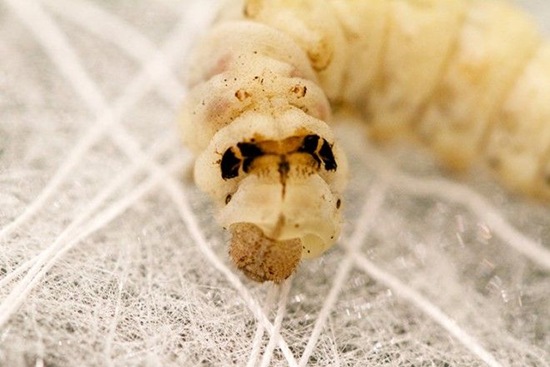
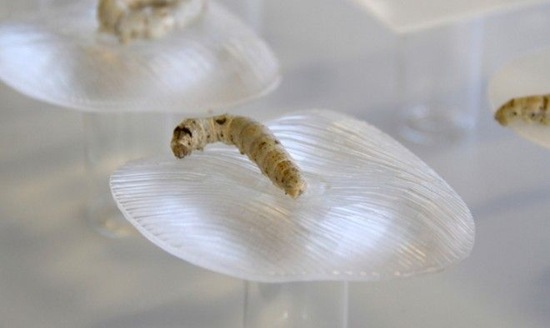
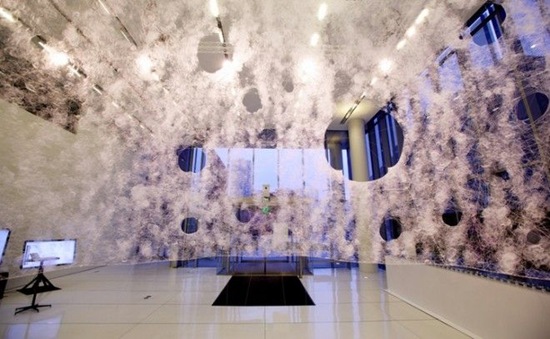
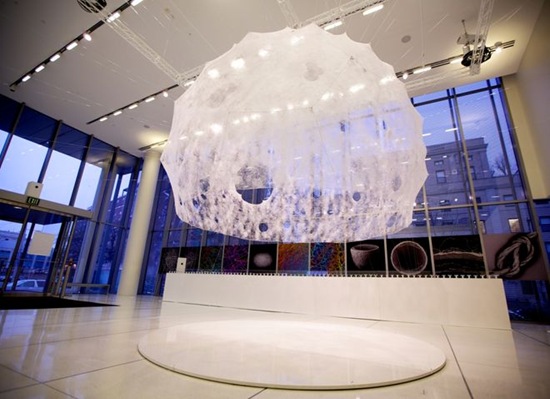
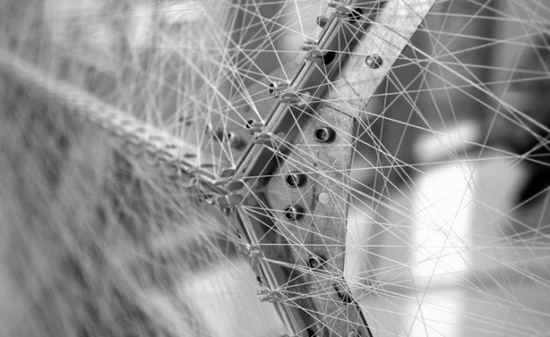
No comments:
Post a Comment
Please adhere to proper blog etiquette when posting your comments. This blog owner will exercise his absolution discretion in allowing or rejecting any comments that are deemed seditious, defamatory, libelous, racist, vulgar, insulting, and other remarks that exhibit similar characteristics. If you insist on using anonymous comments, please write your name or other IDs at the end of your message.